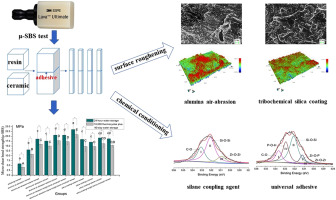Journal of the Mechanical Behavior of Biomedical Materials ( IF 3.9 ) Pub Date : 2018-11-02 , DOI: 10.1016/j.jmbbm.2018.10.034 Xinyi Wu 1 , Haifeng Xie 2 , Hongliang Meng 2 , Lu Yang 2 , Bingzhuo Chen 2 , Ying Chen 2 , Chen Chen 1

|
Objectives
Nanocomposite ceramics have been widely used in clinical practice; however, a standard, recommended bonding protocol has not been determined yet. The present study aimed to evaluate application of tribochemical silica coating or multipurpose products on bonding performance of a CAD/CAM resin-based material (known as nanocomposite ceramic).
Materials and methods
Nanocomposite ceramic specimens were fabricated and assigned into 11 groups to build bonded specimens (n = 15) according to surface treatments (none; air particle abrasion with 50-μm alumina followed by application of a silane coupling agent or a universal adhesive; tribochemical silica coating followed by application of a silane coupling agent or a universal adhesive) and resin luting cements (conventional resin cement, RelyX Veneer; self-adhesive resin cement RelyX Unicem) used. Micro-shear bond strength (μ-SBS) was measured after 24-h water storage or ageing with 10,000 thermocycles plus additional 90-d water storage. Surface roughness after alumina air abrasion and tribochemical silica coating were determined using a profilometer. Surface morphology and element variation were observed by using a scanning electron microscope (SEM)/energy dispersion spectrum (EDS). X-ray photoelectron spectroscopy (XPS) was used to characterize nanocomposite ceramic powders conditioned with silane coupling agent or the universal adhesive used in the μ-SBS test. The nanocomposite ceramic plates received alumina air abrasion, tribochemical silica coating, or without, were determined using X-ray diffraction (XRD).
Results
Nanocomposite ceramic treated with alumina air abrasion achieved the highest surface roughness, followed by those treated with tribochemical silica coating. Newly formed Si–O–Si bonds on the nanocomposite ceramic surface were detected by XPS after treatment with silane coupling agent or universal adhesive, and a Zr–O–P bond was detected after treating with universal adhesive. μ-SBS was significantly affected by bond strategies and ageing. Ageing by thermocycling and water storage significantly decreased μ-SBS. μ-SBS values derived by use of a universal adhesive or self-adhesive resin cement alone were no lower than the values derived by use of a silane coupling agent alone. Pre-silanization further enhanced the bonding improvement of universal adhesive or self-adhesive resin cement. However, tribochemical silica coating failed to provide higher μ-SBS compared with alumina air abrasion. XRD detected no monoclinic zirconia phase after alumina air abrasion or tribochemical silica coating, suggesting that these two roughening methods did not lead to phase transformation of zirconia fillers.
Conclusions
Combination of presilanization and universal adhesives improve resin bonding of nanocomposite ceramics. Tribochemical silica coating is not superior to alumina air abrasion for pretreated nanocomposite ceramics.
中文翻译:

摩擦化学二氧化硅涂层或多功能产品对基于CAD / CAM树脂的材料的粘合性能的影响。
目标
纳米复合陶瓷已被广泛应用于临床。但是,尚未确定标准的推荐绑定协议。本研究旨在评估摩擦化学二氧化硅涂层或多用途产品在CAD / CAM树脂基材料(称为纳米复合陶瓷)的粘结性能上的应用。
材料和方法
制造了纳米复合陶瓷标本,并分为11组以建立粘结标本(n = 15)根据表面处理(无;使用50μm氧化铝对空气颗粒进行磨损,然后施加硅烷偶联剂或通用粘合剂;摩擦化学二氧化硅涂层,然后施加硅烷偶联剂或通用粘合剂)和树脂涂胶水泥(常规树脂水泥,RelyX单板;自粘树脂水泥RelyX Unicem)使用。在10,000个热循环和额外的90天储水量的24小时蓄水或老化后,测量微剪切粘合强度(μ-SBS)。使用轮廓仪测定氧化铝空气磨蚀和摩擦化学二氧化硅涂层后的表面粗糙度。通过使用扫描电子显微镜(SEM)/能量分散谱(EDS)观察表面形态和元素变化。使用X射线光电子能谱(XPS)表征了用硅烷偶联剂或μ-SBS测试中使用的通用胶粘剂处理的纳米复合陶瓷粉末。使用X射线衍射(XRD)确定接受氧化铝空气磨蚀,是否使用摩擦化学二氧化硅涂层的纳米复合陶瓷板。
结果
经氧化铝空气磨蚀处理的纳米复合陶瓷具有最高的表面粗糙度,其次是经摩擦化学二氧化硅涂层处理的纳米复合陶瓷。用硅烷偶联剂或通用胶粘剂处理后,通过XPS检测在纳米复合陶瓷表面上新形成的Si-O-Si键,而使用通用胶粘剂处理后,检测到Zr-O-P键。μ-SBS受键策略和老化的影响很大。通过热循环和储水进行老化可显着降低μ-SBS。单独使用通用粘合剂或自粘树脂胶粘剂得出的μ-SBS值不低于单独使用硅烷偶联剂得出的值。预硅烷化进一步增强了通用胶粘剂或自粘树脂胶粘剂的粘合性能。然而,与氧化铝空气磨损相比,摩擦化学二氧化硅涂层无法提供更高的μ-SBS。XRD在氧化铝空气磨蚀或摩擦化学二氧化硅涂层后未检测到单斜氧化锆相,表明这两种粗糙化方法不会导致氧化锆填料的相变。
结论
预硅烷化和通用粘合剂的组合可改善纳米复合陶瓷的树脂粘合性。对于经预处理的纳米复合陶瓷,摩擦化学二氧化硅涂层并不优于氧化铝空气磨损。



























 京公网安备 11010802027423号
京公网安备 11010802027423号